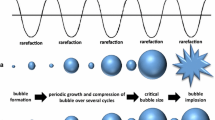Abstract
This work studied the ablation of bovine brain tissue by free-running Erbium-YAG laser pulses. Single-shot interactions were investigated by means of an ultra-fast imaging technique. Thin sections of the treated tissue were processed for histochemical analysis of enzyme activity to assess the extent of thermal/mechanical damage. Thereafter, a scanning beam technique was employed to deliver multiple pulses over a definite region of tissue. An analytical balance was used to measure the removed mass in order to calculate the ablation efficiency. The present quantity has been compared to the amount of the tissue damaged, as assessed by the histochemical analysis. The present work shows that the interaction of the Erbium-YAG laser pulses with a soft tissue may cause a large amount of mechanical damage, while thermal damage is restricted within a thin layer around the ablation crater. A precise control of fluence and operating conditions prevents overwhelming side-effects, and possibly allows the use of the Erbium-YAG laser for the ablation of brain and other soft tissues.
Similar content being viewed by others
References
Quarles GJ, Rosenbaum A, Marquardt CL, Esterowitz L. High-efficiency 2.09µa flashlamp-pumped laser.Appl Phys Lett 1889,55:1062–4
Esterowitz L, Hoffman CA, Tran DC et al. Advantages of the 2.94 µm wavelength for medical laser applications.Proceedings of the Conference on Lasers and Electro-optics, Washington, DC, 1986:122
Hale GM, Querry MR. Optical constants of water in the 200-nm to 200-µm wavelength region.Appl Opt 1973,12:555–63
Bende T, Kriegorowsky M, Seiler T. Photoablation in different ocular tissues performed with an Erbium:YAG laser.Laser Light Ophthalmol 1989,2:263–9
Ross BS, Puliafito CA. Erbium-YAG and Holmium-YAG laser ablation of the lens.Lasers Surg Med 1994,15:74–82
Nuss RC, Fabian RL, Sarkar R, Puliafito CA. Infrared laser bone ablation.Lasers Surg Med 1988,8:381–91
Charlton A, Dickinson MR, King TA, Freemont AJ. Erbium-YAG and Holmium-YAG Laser Ablation of Bone.Lasers Med Sci 1990,5:365–73
Visnuri, SR, Walsh JT Jr, Widgor HA. Erbium laser ablation of dental hard tissue: effect of water cooling.Lasers Surg Med 1996,18:294–300
Walsh JT Jr, Flotte TJ, Deutsch TF. Er:YAG Laser ablation of tissue: effect of pulse duration and tissue type on thermal damage.Lasers Surg Med 1989,9:314–26
Hibst R. Mechanical effects of erbium:YAG laser bone ablation.Lasers Surg Med 1992,12:125–30
Cummings JP, Walsh JT Jr. Tissue tearing caused by pulsed laser-induced ablation pressure.Appl Opt 1993,32:494–502
Krishnamurthy S, Powers SK. Lasers in neurosurgery.Lasers Surg Med 1994,15:126–67
Henriques FC Jr. Studies of thermal injury V. The predictability and the significance of thermally induced rate processes leading to irreversible epidermal injury.Arch Path 1947,43:489–502
Thomsen S. Pathological analysis of photothermal and photomechanical effects of laser-tissue interactions.Photochem Photobiol 1991,53:825–85
Giordano PA, Prosperi E, Bottiroli G. Primary fluorescence of rat muscle after CO2 laser thermal injury.Lasers Surg Med 1984,4:271–8
Verschueren R.The CO 2 Laser in Tumor Surgery. Amsterdam: Van Gorcum, 1976
Dixon M, Webb C.Enzymes, 2nd edn. London: Longmans Green, 1964
Lojda Z, Gossrau R, Schiebler TH.Enzyme Histochemistry: A Laboratory Manual. Berlin: Springer-Verlag, 1979
Barman TE.Enzyme Handbook, Vol 1, II. Berlin: Springer, 1969
Zweig AD, Frenz M, Romano V, Weber HP. A comparative study of laser tissue interaction at 2.94 µn and 10.6 µm.Appl Phys 1988,B47:259–65
Frenz M, Romano V, Zweig AD, Weber HP. Instabilities in laser cutting of soft media.J Appl Phys 1989,66:4496–503
Forrer M, Frenz M, Romano V et al. Channel propagation in water and gelatine by a free running erbium laser.J Appl Phys 1993,74:720–7
Author information
Authors and Affiliations
Rights and permissions
About this article
Cite this article
Cubeddu, R., Sozzi, C., Taroni, P. et al. Study of mechanical and thermal damage in brain tissue after ablation by Erbium-YAG laser. Laser Med Sci 12, 21–30 (1997). https://doi.org/10.1007/BF02763918
Received:
Issue Date:
DOI: https://doi.org/10.1007/BF02763918




